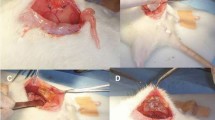Abstract
Purpose
The aim of this study was to investigate the effects of fibrin glue on the prevention of postoperative peritoneal adhesion to prosthetic materials used in ventral hernia repair.
Methods
Ten pigs were included in this study. The abdomens of the animals were opened by means of a median subumbilical laparotomy to place four prostheses that were cut into square pieces of 4 × 4 cm. The two prostheses in the most cephalic position were polypropylene meshes, and the other two prostheses in a more caudal position were expanded polytetrafluoroethylene prostheses (Dualmesh Plus Corduroy). The prostheses on the right side of each animal were previously impregnated with fibrin glue. After 5 weeks, the animals were reoperated on to assess the quantity and quality (consistency) of the adhesions.
Results
There were fewer intraperitoneal adhesions and they were more labile in the case of prostheses impregnated with fibrin glue. Moreover, we also observed that in many of the animals the polypropylene mesh did not show any adhesions, although polypropylene has been considered to be a typical adhesion producing material.
Conclusions
Fibrin glue reduces both the quantity and consistency of adhesions, even in the case of polypropylene meshes.
Similar content being viewed by others
References
Tetik C, Arregui ME, Dulucq JL, Fitzgibbons RJ, Franklin ME, McKernan JB. Complications and recurrences associated with laparoscopic repair of groin hernias: a multi-institutional retrospective analysis. Surg Endosc 1994;8:1316–1322.
Morales-Conde S, Cadet H, Martín-Cartes J, Morales-Méndez S. Management of mesh and sutures during laparoscopic ventral hernia repair: a lesson learned from an experimental study. In: Morales-Conde S, Morales-Méndez S, editors. Laparoscopic ventral hernia repair. París: Springer; 2002. p. 256–267.
Toosie K, Gallego K, Stabile BE, Schaber B, French S, de Virgilio C. Fibrin glue reduces intraabdominal adhesions to synthetic mesh in a rat ventral hernia model. Am Surg 2000;66:41–46.
De Virgilio C, Dubrow T, Sheppard B. Fibrin glue inhibits intra-abdominal adhesion formation. Arch Surg 1990;125:1378–1382.
Sheppard B, de Virgilio C, Bleiweis M. Inhibition of intraabdominal adhesions: fibrin glue in a long-term model. Am Surg 1983;59:786–790.
Chmielewski G, Saxe J, Dulchavsky S. Fibrin glue limits intra-abdominal adhesions formation. Am Surg 1993;58:590–593.
Martínez-Ibáñez V. Use of fibrin sealant in the installation of a “zipper device” in the treatment of necrotizing enteritis. Conference in symposium “Progress in wound healing and tissue repair using fibrin sealing”, XXXVIth Congress of the European Society for Surgical Research. Santiago de Compostela, June 2001.
Martínez-Íbáñez V, Lloret Roca J, Abad Calvo P, Acosta Farina D, Boix-Ochoa J. Fibrin glue (Tissucol) in necrotizing enteritis: new surgical strategies in newborn surgery. Forum Farma 2001;269:49–53.
Nehez L, Vodros D, Axelsson J, Tingstedt B, Lindman B, Andersson R. Prevention of postoperative peritoneal adhesions: effects of lysozyme, polylysine and polyglutamate versus hyaluronic acid. Scand J Gastroenterol 2005;40:1118–1123.
Cohen Z, Senagore AJ, Dayton MT, Koruda MJ, Beck DE, Wolff BG, et al. Prevention of postoperative abdominal adhesions by a novel, glycerol/sodium hyaluronate/carboxymethylcellulosebased bioresorbable membrane: a prospective, randomized, evaluator-blinded multicenter study. Dis Colon Rectum 2005;48(6):1130–1139.
Bae JS, Jin HK, Jang KH. The effect of polysaccharides and carboxymethylcellulose combination to prevent intraperitoneal adhesion and abscess formation in a rat peritonitis model. J Vet Med Sci 2004;66:1205–1211.
Borrazzo EC, Belmont MF, Boffa D, Fowler DL. Effect of prosthetic material on adhesion formation after laparoscopic ventral hernia repair in a porcine model. Hernia 2004;8:108–112.
Waclawiczek HW. Fibring sealing in visceral surgery for the prevention and treatment of postoperative complications. Conference in symposium “Progress in wound healing and tissue repair using fibrin sealing,” XXXVIth Congress of the European Society for Surgical Research. Santiago de Compostela, June 2001.
Burns JW, Skinner K, Colt MJ, Burgess L, Rose R, Diamond MP. A hyaluronate based gel for the prevention of postsurgical adhesions: evaluation in two animal species. Fertil Steril 1996;66: 814.
Baptista ML, Bonsack ME, Felemovicius I, Delaney JP. Abdominal adhesions to prosthetic mesh evaluated by laparoscopy and electrón microscopy. J Am Coll Surg 2000;190:171–180.
Dabrowiecki S, Svanes K, Levken J, Grong K. Tissue reaction to polypropylene mesh: a study of oedema, blood flow, and inflammation in the abdominal wall. Eur Surg Res 1991;23:240–249.
Morales-Méndez S, Morales Conde S, Ponce González JF, Barri-ga Beltrán R, Gavilán Carrasco F, Fernández Álvarez V. Use of prosthesis in the surgical treatment for incisional hernia: experimental and clinical study. In: Porrero JL, editor. Abdominal wall surgery. Barcelona: Masson; 1997. p. 257–268.
Bellón JM, Buján J, Contreras LA, Hernando A. Integration of biomaterials implanted into abdominal wall: process of scar formation and macrophage response. Biomaterials 1995;16:381–387.
Bellón JM, Buján J, Contreras LA, Hernando A, Jurado F. Macrophage response to experimental implantation of polypropylene prosthesis. Eur Surg Res 1994;26:46–53.
Bellón JM, Contreras LA, Buján J, Carrera-San Martín A, Gimeno MJ, Jurado F. Influence of the porosity of prosthetic biomaterials implanted in the abdominal wall on the healing process. Cir Esp 1996;57:296–302.
Bellón JM, Buján J, Contreras LA, Hernando A. Interface formed between visceral peritoneum and experimental polypropylene or polytetrafluoroethylene abdominal wall implants. J Mat Sci (MMed) 1996;7:331–336.
Kaufman Z, Engelberg M, Zager M. Faecal fistula: a late complication of Marlex mesh repair. Dis Colon Rectum 1981;24: 543–544.
Liakakos T, Thomakos N, Fine PM, Dervenis C, Young RL. Peritoneal adhesions: etiology, pathophysiology and clinical significance: recent advances in prevention and management. Dig Surg 2001;18:260–273.
Wrijland WW, Bonthius F, Sleyerberg EW, Marquet RL, Jaeckel J, Bonjer HJ. Peritoneal adhesions to prosthetic materials: choice of mesh for incisional hernia repair. Surg Endosc 2000;14:960–963.
Murphy JL, Freeman JB, Dionne PG. Comparison of Marlex and Gore-tex to repair abdominal wall defects in the rat. Can J Surg 1989;32:244–247.
Author information
Authors and Affiliations
Rights and permissions
About this article
Cite this article
Martín-Cartes, J.A., Morales-Conde, S., Suárez-Grau, J.M. et al. Role of fibrin glue in the prevention of peritoneal adhesions in ventral hernia repair. Surg Today 38, 135–140 (2008). https://doi.org/10.1007/s00595-007-3590-9
Received:
Accepted:
Published:
Issue Date:
DOI: https://doi.org/10.1007/s00595-007-3590-9




